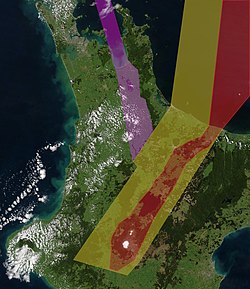
The Taupō Volcanic Zone (TVZ) is a volcanic area in the North Island of New Zealand. It has been active for at least the past two million years and is still highly active.

The Kapenga Caldera in New Zealand’s Taupō Volcanic Zone lies in a low land area immediately south of Lake Rotorua through the Hemo Gap in the Rotorua Caldera rim. At some time more than 60,000 years ago Lake Rotorua drained through the Hemo Gap and some of the Kapenga Caldera floor was likely occupied by a lake, that has been called Kapenga.

Ōkataina Caldera is a volcanic caldera and its associated volcanoes located in Taupō Volcanic Zone of New Zealand's North Island. It has several actual or postulated sub calderas. The Ōkataina Caldera is just east of the smaller separate Rotorua Caldera and southwest of the much smaller Rotomā Embayment which is usually regarded as an associated volcano. It shows high rates of explosive rhyolitic volcanism although its last eruption was basaltic. The postulated Haroharo Caldera contained within it has sometimes been described in almost interchangeable terms with the Ōkataina Caldera or volcanic complex or centre and by other authors as a separate complex defined by gravitational and magnetic features.. Since 2010 other terms such as the Haroharo vent alignment, Utu Caldera, Matahina Caldera, Rotoiti Caldera and a postulated Kawerau Caldera are often used, rather than a Haroharo Caldera classification.

The relatively small Rotomā Caldera is in the Taupō Volcanic Zone in the North Island of New Zealand.

The Waihi Fault Zone is a seismically active area of the central North Island of New Zealand whose earthquakes have been associated with significant loss of life.

The Poutu Fault Zone is a seismically active area of the central North Island of New Zealand.

The Hauraki Rift is an active NeS-to NWeSE-striking rift valley system in the North Island of New Zealand that has produced the Firth of Thames and the Hauraki Plains. It is approximately 25 kilometres (16 mi) wide and 250 kilometres (160 mi) long.

Maunga Kākaramea is a 743 metres (2,438 ft) high dacite volcano located between Rotorua and Taupō in the North Island Volcanic Plateau. It has multiple steaming features and a picturesque crater lake reached by a short walk from the nearest road and has a nearby geothermal area.

Maungaongaonga is an 825 metres (2,707 ft) high dacite volcano located between Rotorua and Taupō in the North Island Volcanic Plateau. The area of the mountain is a scenic reserve and some of its southern slopes are highly geothermally active.

The Paeroa Fault is a seismically active area in the Taupō District, Waikato Region of the central North Island of New Zealand.

The Ngapouri-Rotomahana Fault is a seismically and volcanically active area of the central North Island of New Zealand.

The Ōkāreka Embayment is a volcanic feature in Taupo Volcanic Zone of New Zealand. Its most significant recent volcanic eruption was about 15,700 years ago and this deposited the widespread Rotorua tephra that reached beyond Auckland.

The Horohoro Fault is in the old Taupō Rift of the central North Island of New Zealand and is associated with the spectacular Horohoro cliffs.
The Taupō Fault Belt contains many almost parallel active faults, and is located in the Taupō Rift of the central North Island of New Zealand geographically between Lake Taupō and the lakes of Rotorua, Tarawera, Rotomahana and Rerewhakaaitu. The potential active fault density is very high, with only 0.1 to 1 km separating the north-east to south-west orientated normal fault strands on detailed mapping of part of the belt. The Waikato River bisects the western region of the belt.

The Tikitere Graben is a intra-rift graben in the North Island of New Zealand that contains the Ohau Channel, which drains Lake Rotorua into Lake Rotoiti with a minimal drop between the lakes.

The Coromandel Volcanic Zone (CVZ) is an extinct intraplate volcanic arc stretching from Great Barrier Island in the north, through the Coromandel Peninsula, to the Kaimai Range in the south. The area of transition between it and the newer and still active Taupō Volcanic Zone is now usually separated and is called the Tauranga Volcanic Centre. Its volcanic activity was associated with the formation and most active period of the Hauraki Rift.
Much of the volcanic activity in the northern portions of the North Island of New Zealand is recent in geological terms and has taken place over the last 30 million years. This is primarily due to the North Island's position on the boundary between the Indo-Australian and Pacific Plates, a part of the Pacific Ring of Fire, and particularly the subduction of the Pacific Plate under the Indo-Australian Plate. The activity has included some of the world's largest eruptions in geologically recent times and has resulted in much of the surface formations of the North Island being volcanic as shown in the map.
The Manawahe Fault line is a seismically active area in the Bay of Plenty Region of the central North Island of New Zealand with the potential to be involved with other faults in an 7.0 event.
The Whakatāne Graben is a predominantly normal faulting tectonic feature of the northeastern aspect of the young, modern Taupō Rift in New Zealand. At the coast it is widening by about 7 mm (0.28 in)/year. This very geologically active graben was the site of the 1987 Edgecumbe earthquake, which caused up to 2 m of land subsidence. The discontinuity in the Taupō Volcanic Zone's faults imposed by the highly active Ōkataina Volcanic Centre, geography and geology mean the graben is usually regarded as including the actively expanding and lowering region onshore extending towards the coast. Some scientists have limited the Whakatāne Graben to only the offshore continuation of the Taupō Rift.
The Matata Fault zone is a seismically active area in the Bay of Plenty Region of the central North Island of New Zealand with potential to rupture as part of an Mw 7.0 event.














